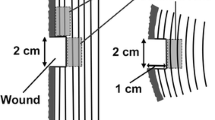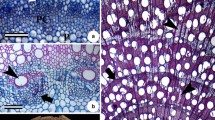Summary
The early-formed xylem of Suaeda monoica Forssk. ex J. F. Gmel (Chenopodiaceae) is temporarily rayless. Vascular rays differentiate during later stages of its xylem ontogeny. The rays in Suaeda are heterogeneous, and some of them are aggregated. The mature xylem of this species is characterized by two unique types of vascular rays: (1) rays with several inside initiation “centres” of small cells formed by local frequent cell divisions in the cambium, and (2) huge xylem rays with radial phloem strands that are connected to the axial phloem. The spacing of the xylem rays is not even, and possible mechanisms controlling ray spacing are discussed. Our observations indicate that rays do not have an inhibitory zone around them in which ray initiation is prevented. The initiation of radial patterns of small cells which appear like inside “rays” within a large vascular ray suggests that initiation and spacing of rays is controlled by radial signal flows in relationship with axial signal fluxes.
Similar content being viewed by others
References
Ajmal S, Khan R, Iqbal M (1986) Cambial structure of Holoptelea integrifolia Planch. in relation to age. Flora (Jena) 178: 197–202
Aloni R (1980) Role of auxin and sucrose in the differentiation of sieve and tracheary elements in plant tissue cultures. Planta 150: 255–263
Aloni R (1987a) Differentiation of vascular tissues. Annu Rev Plant Physiol 38: 179–204
Aloni R (1987b) The induction of vascular tissues by auxin. In: Davies PJ (ed) Plant hormones and their role in plant growth and development. Nijhoff/Junk, The Hague, pp 363–374
Aloni R (1991) Wood formation in deciduous hardwood trees. In: Raghavendra AS (ed) Physiology of trees. Wiley, New York (in press)
Aloni R, Gad AE (1982) Anatomy of the primary phloem fiber system in Pisum sativum. Am J Bot 69: 979–984
Aloni R, Zimmermann MH (1983) The control of vessel size and density along the plant axis — a new hypothesis. Differentiation 24: 203–208
Baas P, Schmid R, Heuven BJ van (1986) Wood anatomy of Pinus longaeva (bristlecone pine) and the sustained length-on-age increase of its tracheids. IAWA Bull 7: 221–228
Bailey IW (1911) The relation of the leaf-trace to the formation of compound rays in the lower dicotyledons. Ann Bot 25: 225–241
Bailey IW (1912) The evolutionary history of the foliar ray in the wood of the dicotyledons, and its phylogenetic significance. Ann Bot 26: 647–661
Bannan MW (1951) The annual cycle of size changes in the fusiform cambial cells of Chamaecyparis and Thuja. Can J Bot 29: 421–437
Bannan MW (1953) Further observations on the reduction of fusiform cambial cells in Thuja occidentalis. Can J Bot 31: 63–74
Bannan MW (1965) Ray contacts and rate of anticlinal division in fusiform cambial cells of some Pinaceae. Can J Bot 43: 487–507
Barghoorn ES Jr (1940) The ontogenetic development and the phylogenetic significance of rays in the xylem of dicotyledons. I. The primitive ray structure. Am J Bot 27: 918–928
Barghoorn ES Jr (1941a) The ontogenetic development and phylogenetic specialization of rays in the xylem of dicotyledons-III. The elimination of rays. Bull Torrey Bot Club 68: 317–325
Barghoorn ES Jr (1941b) The ontogenetic development and phylogenetic specialization of rays in the xylem of dicotyledons. II. Modification of the multiseriate and uniseriate rays. Am J Bot 28: 373–382
Bhat KM, Bhat KV, Dhamodaran TK (1989) Fibre length variation in stem and branches of eleven tropical hardwoods. IAWA Bull 10: 63–70
Bosshard HH (1965) Aspects of the aging process in cambium and xylem. Holzforschung 19: 65–69
Botosso DC, Vidal Gomes A (1982) Radial vessels and series of perforated ray cells in Annonaceae. IAWA Bull 3: 39–44
Braun HJ (1955) Beiträge zur Entwicklungsgeschichte der Markstrahlen. Bot Stud 4: 73–131
Braun HJ (1970) Funktionelle Histologie der sekundaren Sprossachse. I. Das Holz. Borntraeger, Berlin
Bruyne AS de (1952) Wood structure and age. Proc K Ned Adad Wet Ser C Biol Med Sci 55: 282–286
Bünning E (1952) Morphogenesis in plants. Surv Biol Prog 2: 105–140
Bünning E (1965) Die Entstehung von Mustern in der Entwicklung von Pflanzen. Handb Pflanzenphysiol 15: 383–408
Carlquist S (1962) A theory of paedomorphosis in dicotyledonous woods. Phytomorphology 12: 30–45
Carlquist S (1966) Wood anatomy of Compositae. A summary, with comments on factors controlling wood evolution. Aliso 6: 25–44
Carlquist S (1970) Wood anatomy of insular species of Plantago and the problem of raylessness. Bull Torrey Bot Club 97: 353–361
Carlquist S (1988) Comparative wood anatomy: systematic, ecological, and evolutionary aspects of dicotyledon wood. In: Timell TE (ed) Springer series in wood science. Springer, Berlin Heidelberg New York, pp 436
Carlquist S, Zona S (1988) Wood anatomy of Acanthaceae: a survey. Aliso 12: 201–227
Carmi A, Sachs T, Fahn A (1972) The relation of ray spacing to cambial growth. New Phytol 71: 349–353
Catesson A-M (1980) The vascular cambium. In: Little CHA (ed) Control of shoot growth in trees. Proceedings of the joint workshop IUFRO working parties on xylem physiology and shoot growth physiology. Fredericton, Canada, pp 12–40
Chattaway MM (1936) Relation between fibre and cambial initial length in dicotyledonous woods. Trop Woods 46: 16–20
Cheadle VI, Esau K (1964) Secondary phloem of Liriodendron tulipifera. Univ Calif Publ Bot 36: 143–252
Dinwoodie JM (1961) Tracheid and fibre length in timber: a review of literature. Forestry 34: 125–144
Eames AJ (1910) On the origin of the broad ray in Quercus. Bot Gaz 49: 161–167
Evert RF (1961) Some aspects of cambial development in Pyrus communis. Am J Bot 48: 479–488
Fahn A (1982) Plant anatomy, 3rd edn. Pergamon, Oxford
Fahn A, Werker E, Baas P (1986) Wood anatomy and identification of trees and shrubs from Israel and adjacent regions. The Israel Academy of Sciences and Humanities, Jerusalem
Gersani M (1987) Vessel differentiation along different tissue polarities. Physiol Plant 70: 516–522
Ghouse AKM, Hashmi S (1980) Changes in the vascular cambium of Polyalthia longifolia Benth. et Hook, (Annonaceae) in relation to the girth of the axis. Flora (Jena) 170: 135–143
Ghouse AKM, Iqbal M (1975) A comparative study on the cambial structure of some arid zone species of Acacia and Prosopis. Bot Not 128: 327–331
Ghouse AKM, Iqbal M (1977) Variation trends in the cambial structure of Prosopis spicigera L. in relation to the girth of the tree axis. Bull Torrey Bot Club 104: 197–201
Ghouse AKM, Yunus M (1973) Some aspects of cambial development in the shoots of Dalbergia sissoo Roxb. Flora (Jena) 162: 549–558
Ghouse AKM, Yunus M (1976) Cell length variation in the secondary phloem of Dalbergia ssp. with increasing age of the vascular cambium. Ann Bot 40: 13–16
Gibson AC (1978) Rayles secondary xylem of Halophytum. Bull Torrey Bot Club 105: 39–44
Harris JM (1969) On the causes of spiral grain in corewood of radiata pine. N Z J Bot 7: 189–213
Harris JM (1973) Spiral grain and xylem polarity in radiata pine: microscopy of cambial reorientation. N Z J For Sci 3: 363–378
Harris JM (1989) Spiral grain and wave phenomena in wood formation. In: Timell TE (ed) Springer series in wood science. Springer, Berlin Heidelberg New York, pp 214
IAWA Committee on Nomenclature (1964) Multilingual glossary of terms used in wood anatomy. Konkordia, Winterthur, Switzerland
IAWA (1989) List of microscopic features for hardwood identification. IAWA Bull 10: 219–332
Iqbal M, Ghouse AKM (1987) Anatomy of the vascular cambium of Acacia nilotica (1.) Del. var. lelia Troup (Mimosaceae) in relation to age and season. Bot J Linn Soc 94: 385–397
Jeffrey EC (1917) The anatomy of woody plants. University of Chicago Press, Chicago
Jensen WA (1962) Botanical histochemistry. Freeman, San Francisco
Kirschner H, Sachs T, Fahn A (1971) Secondary xylem reorientation as a special case of vascular tissue differentiation. Isr J Bot 20: 184–198
Krawczyszyn J (1971) Unidirectional splitting and uniting of rays in the cambium of Platanus accompanying the formation of interlocked grain in wood. Acta Soc Bot Pol 40: 57–79
Krawczyszyn J (1972) Movement of the cambial domain pattern and mechanism of formation of interlocked grain in Platanus. Acta Soc Bot Pol 41: 443–461
Kribs DA (1935) Salient lines of structural specialization in the wood rays of dicotyledons. Bot Gaz 96: 547–557
Kučera LJ, Bosshard HH (1975) The presence of biseriate rays in fir (Abies alba Mill.). IAWA Bull 1975: 51–56
Metcalfe CR, Chalk L (1950) Anatomy of the dicotyledons. Clarendon, Oxford
Moseley MF (1948) Comparative anatomy and phytogeny of the Casuarinaceae. Bot Gaz 110: 231–280
Neeff F (1914) Über Zellumlagerung. Ein Beitrag zur experimentellen Anatomie. Z Bot 6: 465–545
Noskowiak AF (1978) Distribution of aggregated rays in red alder. Wood Fiber 10: 58–68
Ohtani J, Fukazawa K, Fukumorita T (1987) SEM observations on indented rings. IAWA Bull 8: 113–124
Outer RW den, Veenendaal WLH van (1981) Wood and bark anatomy of Azima tetracantha Lam. (Salvadoraceae) with description of its included phloem. Acta Bot Neerl 30: 199–207
Paliwal GS, Srivastava LM (1969) The cambium of Asleuosmia. Phytomorphology 19: 5–8
Philipson WR, Ward JM, Butterfield BG (1971) The vascular cambium. Chapman and Hall, London
Pizzolato TD (1982) Anatomical modification by 2,4-DB of vascular cambium and secondary xylem in soybean internodes. Can J Bot 60: 2142–2146
Pyszynski W (1972) Downward movement of the domain pattern in Aesculus cambium producing wavy-grained xylem. Acta Soc Bot Pol 41: 511–517
Rao KS (1988) Cambial activity and developmental changes in ray initials of some tropical trees. Flora (Jena) 181: 425–434
Roberts LW, Gahan PB, Aloni R (1988) Vascular differentiation and plant growth regulators. In: Timell TE (ed) Springer series in wood science. Springer, Berlin Heidelberg New York, pp 154
Sachs T (1981) The control of patterned differentiation of vascular tissues. Adv Bot Res 9: 151–262
Saks Y, Aloni R (1985) Polar gradients of tracheid number and diameter during primary and secondary xylem development in young seedlings of Pinus pinea L. Ann Bot 56: 771–778
Savidge RA, Farrar JL (1984) Cellular adjustments in the vascular cambium leading to spiral grain formation in conifers. Can J Bot 62: 2872–2879
Srivastava LM (1963) Secondary phloem in the Pinaceae. Univ Calif Publ Bot 36: 1–142
Stebbins GL (1974) Flowering plants, evolution above the species level. Harvard University Press, Cambridge, Mass.
Thompson WP (1911) On the origin of the multiseriate ray of the Dicotyledons. Ann Bot 25: 1005–1014
Tupper-Carey RM (1930) Observations on the anatomical changes in tissue bridges across rings through the phloem of trees. Leeds Phil Lit Soc Sci Sec 2: 86–94
Vliet GJCM van (1976) Radial vessels in rays. IAWA Bull 1976: 35–37
Waisel Y, Ovadia S (1972) Biological flora of Israel. 3. Suaeda monoica Forssk. ex J. F. Gmel. Isr J Bot 21: 42–52
Ziegler H (1964) Storage, mobilization and distribution of reserve material in trees. In: Zimmermann MH (ed) The formation of wood in forest trees. Academic Press, New York, pp 303–320
Author information
Authors and Affiliations
Rights and permissions
About this article
Cite this article
Lev-Yadun, S., Aloni, R. Polycentric vascular rays in Suaeda monoica and the control of ray initiation and spacing. Trees 5, 22–29 (1991). https://doi.org/10.1007/BF00225331
Received:
Accepted:
Issue Date:
DOI: https://doi.org/10.1007/BF00225331




